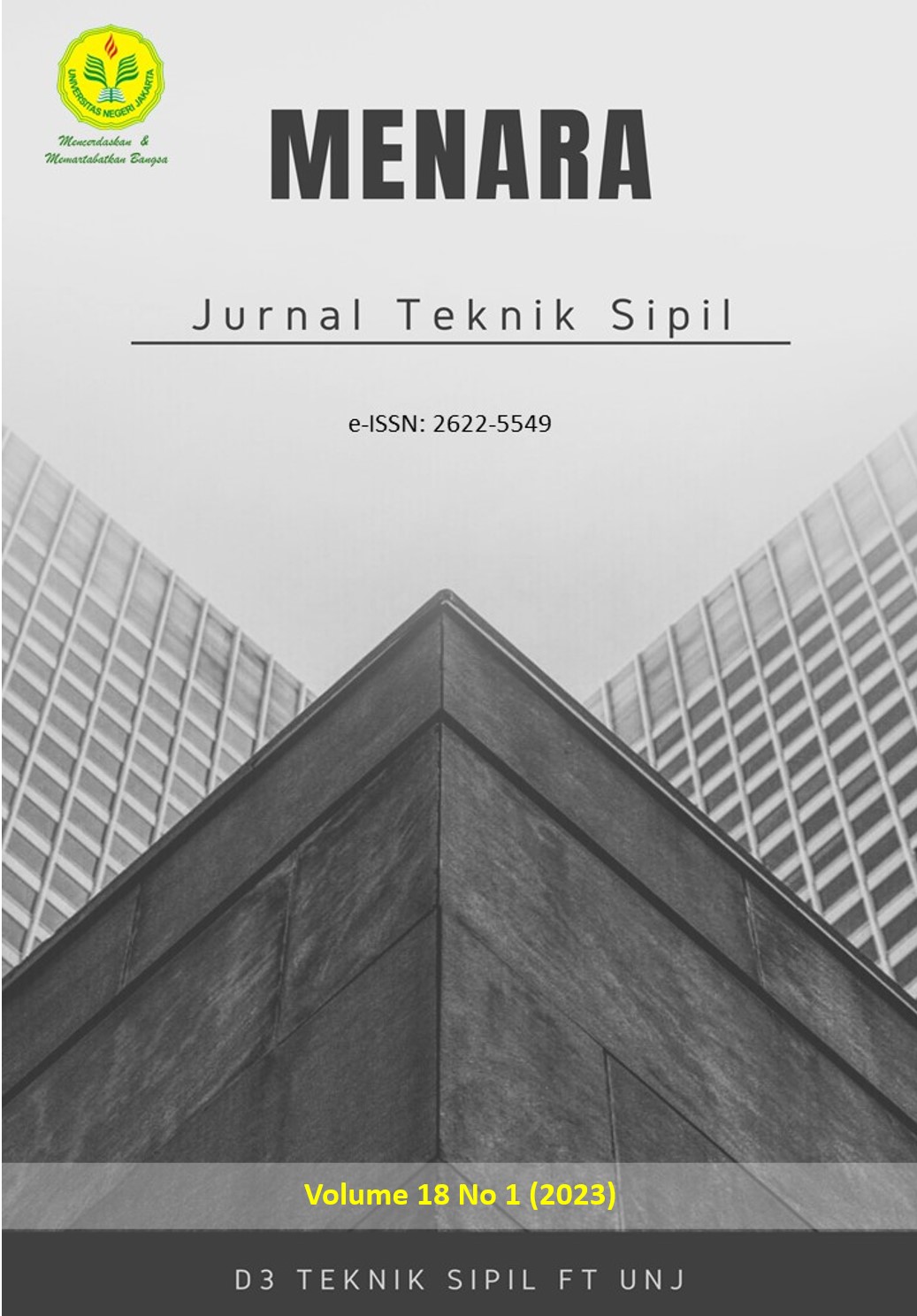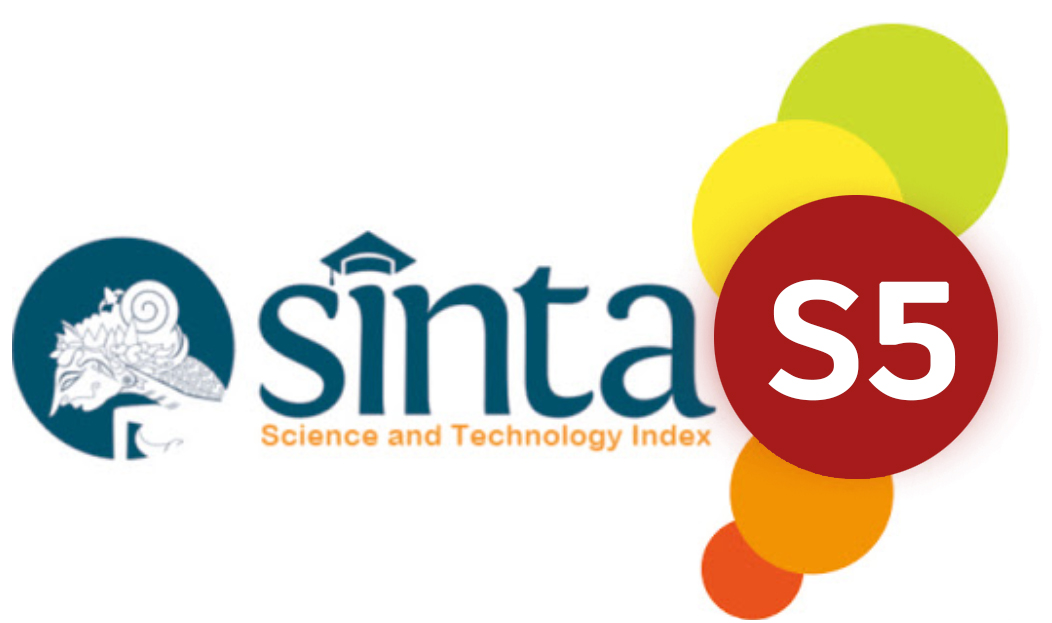PEMANFAATAN CAMPURAN FLY ASH DAN LDPE SEBAGAI SUBTITUSI AGREGAT HALUS PADA PAVING BLOCK
DOI:
https://doi.org/10.21009/jmenara.v18i1.26157Keywords:
Fly ash, LDPE, Fine Aggregate, Paving BlockAbstract
Paving blocks are product building cement, aggregate and water used as ground pavement. This study aims to determine the characteristics of paving blocks by utilizing Fly Ash and LDPE as partial sand substitution so that it can be seen their effect on quality requirements referring to SNI 03-0691-1996. This study uses experiment method with paving block specimens measuring 210 mm x 105 mm x 60 mm in form of beam. Utilization Fly Ash and LDPE as partial substitution of fine aggregate with various percentages of 0%, 5%, 7.5%, 10%, 12.5% and 15%. Tests on the specimens were carried out at of 28 days in accordance SNI 03-0691-1996 regarding paving blocks, in the form of compressive strength tests, wear resistance tests and water absorption tests. The results of this study indicate that the effect of using Fly Ash and LDPE on paving blocks can improve its quality with the right proportions. The optimum compressive strength is found in variations of 0% and 7.5%, respectively, of 17.2 MPa and 20 MPa.. Variations of 5%, 7.5%, 10%, and 12.5% fall into grade A for wear resistance testing. In the water absorption test, the variation of 7.5% and 12.5% is classified as B quality.
References
Acha dan Andi. (2018). Survei Proses Pembelajaran Pendidikan Jasmani Anak Tuna Grahita Di Slb Kota Langsa. Jurnal Olahraga Rekreasi Samudra, 1(1):16-26.
Baidowi, Ahmad Ajib. (2018). Hubungan Antara Kekuatan Otot Lengan Dan Kelentukan Otot Punggung Dengan Ketepatan Smash Permainan Bola Voli Pada Siswa Yang Mengikuti Ekstrakurikuler Di Smpn 1 Jogorogo. Simki-Techsain, 02(3):36-42
Basyarudin, Acha dan Andi Nova. (2018). Survei Proses Pembelajaran Pendidikan Jasmani Anak Tuna Grahita Di Slb Kota Langsa. Jurnal Ilmu Olahraga, Kesehatan dan Rekreasi, 1(1):16-26.
Battou, Amal. (2017). Designing an Adaptive Learning System Based on a Balanced Combination of Agile Learner Design and Learner Centered Approach. American Scientific Research Journal for Engineering, Technology, and Sciences. 1(3): 14-29.
Battou, Amal. (2017). Designing an Adaptive Learning System Based on a Balanced Combination of Agile Learner Design and Learner Centered Approach. American Scientific Research Journal for Engineering, Technology, and Sciences, 5(1):178-186.
Dana Perlman, Cindy,B. M., Piletic, Groon. (2012). The Influence of an Adapted Physical Education Course on Preservice Teacher Instruction: Using a Self-Determination Lens. Australian Journal of Teacher Education, 5(2): 14-25.
Dwijayanti, Karlina. (2017). Hubungan Antara Kekuatan Otot Lengan Dengankekuatan Otot Perut Terhadap Kemampuan Servis Atas Bola Voli Pada Siswa Putra Kelas X Sma Negeri 1 Ngemplak Tahun Pelajaran 2016/2017. Jurnal Ilmiah PENJAS, 3(1):27-33.
Fatmawati, Indah. (2017). Pelaksanaan Pembelajaran Olahraga Bola Bocce Untuk Anak Tunagrahita Di Slb Asih Budi I. Jurnal Ilmiah PENJAS, 3(1):23-34.
Hera, Yuniartik., Hidayah & Nasuka. (2017). Evaluasi Pembelajaran Pendidikan Jasmani Olahraga dan Kesehatan di SLB C Se-Kota Yogyakarta. Journal of Physical Education and Sports, 6(2):146-153. http://journal.unnes.ac.id/sju/index.php/jpes.
Kurniasari, Dwi Ayu. (2018). Hubungan Kekuatan Otot Lengan, Kelentukan Otot Togok Dan Power Otot Kaki Dengan Hasil Smash Ekstrakulrikuler Bolavoli Siswa Putra Man 3 Kediri Tahun 2017, Simki-Techsain, 02(3):1-11.
Lukman, Anirotul. (2016). Qori’ah Survei Pelaksanaan Proses Pembelajaran Penjasorkes Pada Siswa di Sekolah Luar Biasa (SLB) Duladi. Journal of Physical Education, Sport, Health and Recreation, 5(2):60-71.
Maj’d, Ardhi Ahmad, Werda Farid. (2018). Hubungan Antara Kekuatan Otot Lengan, Panjang Lengan, Dan Koordinasi Mata Tangan Dengan Kemampuan Servis Atas Bolavoli Siswa Putra Kelas Xi Ipa A, Xi Ipa B, Xi Ipa C Sma Negeri 4 Kediri. Simki-Techsain, 02(3):21-31
Palupi, M.K and Edy K.L. (2018). Kontribusi Kekuatan Otot Lengan, Kekuatan Otot Perut, Daya Ledak Otot Tungkai, Dan Antropometri Pada Prestasi Lempar Cakram. Jurnal Prestasi Olahraga, 3(3): 30-41.
Pate and Rotella. (2013). Scientific Foundation of Coaching (Ahli bahasa), UNNES: Semarang.
Penggalih, Mirza dan Marina Hardiyanti. (2016). Pengaruh Perbedaan Intensitas Latihan Atlet Sepeda Terhadap Berat Badan dan Body Water. Journal of Physical Education, Sport, Health and Recreation, 5(1):13-21.
Prawati & Abdul. (2015). Pengaruh Olahraga Permainan Rekreatif Dalam Meningkatkan Gerak Dasar Manipulatif (Menendang) Siswa Tunagrahita Ringan. Jurnal Pendidikan Olahraga dan Kesehatan Volume 3(2): 406-411.
Rahmawati, S. W., & Jagakarsa, U. T. (2012). Penanganan Anak Tuna Grahita (Mental Retardation) dalam Program Pendidikan Khusus. 1(May), 27.
Ressy Agustin, Noortje Anita Kumaat. (2017) Pengaruh Modifikasi Permainan Menendang Bola Terhadap Koordinasi Gerak Manipulatif Anak Tunagrahita Ringan Siswa Smplb-C Alpha Kumara Wardhana Ii Surabaya. Junral Adapif Indonesia, 3(1): 56—80. http://jurnalmahasiswa.unesa.ac.id/index.php/jurnalkesehatanolahraga/article/view/22-134/baca-artikel.
Syafruddin. (2016). Ilmu kepelatihan olahraga umum. Padang. UNP Press.
Syarial, Arif. (2017). Kontribusi Kekuatan Otot Lengan Dan Kelincahan Terhadap Half Nelson Pada Atlet Gulat Provinsi Bengkulu. Jurnal Ilmiah Pendidikan Jasmani, 1(1):11-21.
Tangkudung, James (2018). Metodologi Penelitian, (Kajian dalam Olahraga, 2018) h 105
Zuzana. (2015). Kontribusi Daya Tahan Kekuatan Otot Lengan Dan Kelentukan Terhadap Kemampuan Mendayung Dragon Jarak 500 Meter Atlet Dayung Kabupaten Padang Pariaman. Jurnal Ilmiah PENJAS, 3(1):50-63.
Downloads
Published
Issue
Section
License
Authors who publish with this Journal agree to the following terms:
- Author retain copyright and grant the journal right of first publication with the work simultaneously licensed under a creative commons attribution licensethat allow others to share the work within an acknowledgement of the work’s authorship and initial publication of this journal.
- Authors are able to enter into separate, additional contractual arrangementfor the non-exclusive distribution of the journal’s published version of the work (e.g. acknowledgement of its initial publication in this journal).
- Authors are permitted and encouraged to post their work online(e.g. in institutional repositories or on their websites) prior to and during the submission process, as it can lead to productive exchanges, as well as earlier and greater citation of published works.











